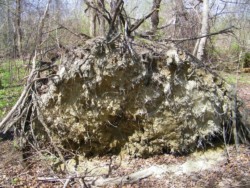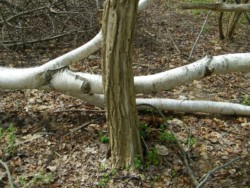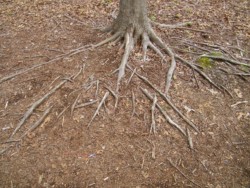I decided to honor the first stanza of Mary Oliver’s poem titled HOW I GO TO THE WOODS:
“Ordinarily I go to the woods alone,
with not a single friend,
for they are all smilers and talkers, and therefore unsuitable.”
I grabbed my camera, note pad and drove to Gardiners County Park. I found a way to avoid the pets and pet walkers. I’ll take lesser-used trails or bushwhack. This was a last minute decision. I could wander as I please and, pause when I felt like it.
The park’s shape is a rough square. I have not covered the entire park and eventually will since I live close by and can take my time. The forest canopy has not yet leafed out so plenty of sunlight reached the forest floor. I found a little used trail after leaving a favorite used by dog walkers.
Within minutes, I was struck by the abundance of Canada Mayflower. Carpets of thousands of shiny green leaves had yet to produce their flowers. These plants are perennial and have an extensive underground root system. The green forest floor is a pleasant surprise because it disappears here and I walked past many blow down trees. The force of Hurricane Sandy winds has left an indelible mark in these woods. Massive upended stumps and horizontal trunks were obvious victims of hurricane-force winds. The leaves of these blow downs proved to be their end. Their canopy acted like a sail and forced them down. Just looking at the stumps and their roots indicated a huge amount of force needed to upend them. I took photos and when I looked at them later, they looked like the jaws of a dragon. These trees will take decades to decompose and become part of the soil.
I came to a green patch and decided to rest. I soon discovered that I was lying on a large patch of Smooth Solomon Seal. There must have been a few hundred small plants here. I pulled one to sketch at home. Back home, I looked in my Audubon Society Field Guide to North American Wildflowers. It explained how this plant got its’ common name:
“The rootstock, or rhizome of the Solomon’s Seals is jointed; the leaf stalk breaks away from it, leaving a distinctive scar said to resemble the official seal of King Solomon. Indians and colonists used the starchy rhizomes as food.” P. 605
Nearby, I found the fuzzy fiddleheads of Cinnamon Fern, a charming start for a fern that will grow to three feet high and turn a cinnamon color in the fall. The fiddle heads look like the tops of violins and are so fuzzy that a few species of warblers use this for lining their nests.
Throughout the forest, I found many gray birch trees, some standing, and many more on the ground. The white bark of these trees is unmistakable. I found one piece of bark that had lines of sapsucker holes. The bark lasts longer than the wood that it covers. This is because of the high oil content in the bark.
As I walked through the forest, I could pick out the gray birches easily. “They were more common back in the 40-50’s than now.” Said Darrel Ford, my 86 year old friend. “Long Island was almost totally different in the early 1940s compared to now.” He said. “Most of the forests are gone.”
The huge downed trees, for me, are a metaphor for the terror of Sandy. The wrath of their winds destroyed property. However, I would not use the term for nature. Destroy is good term for human property, not nature. I could imagine the thunderous thud sounds as huge, mature trees hit the ground. And the sounds of crashing limbs as they broke by the falling trunks, then the minor quaking of the earth nearby. So too are the birches metaphors for those of us escaped to higher ground to evacuate.





Leave a Reply